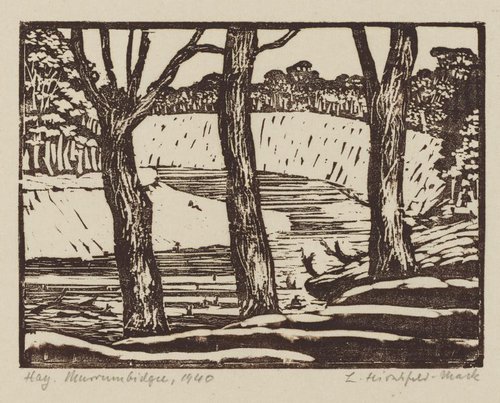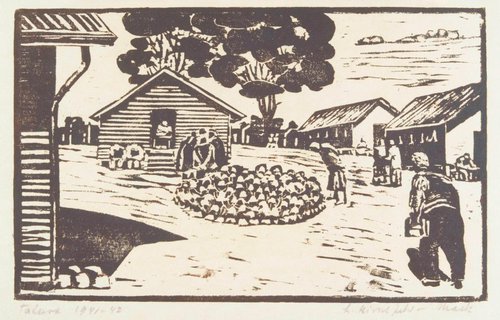Title
Desolation, Internment camp, Orange, NSW
1941
Artist
-
Details
- Other Title
- Desolation, Internment camp
- Place where the work was made
-
Orange
→
New South Wales
→
Australia
- Date
- 1941
- Media category
- Materials used
- woodcut, printed in black ink on thin ivory wove paper
- Edition
- Unknown
- Dimensions
- 21.6 x 13.5 cm blockmark; 33.6 x 21.0 cm sheet
- Signature & date
Signed l.l. below blockmark, pencil "L. H. Mack".
Dated l.r. below blockmark, pencil ".../ 1941".- Credit
- Gift of Olive Hirschfeld, the artist's widow 1970
- Location
- Not on display
- Accession number
- DA9.1970
- Copyright
- © Reproduced with permission
- Artist information
-
Ludwig Hirschfeld-Mack
Works in the collection
- Share
-
-
About
Ludwig Hirschfeld-Mack was born at Frankfurt-am-Main, Germany and arrived in Australia in September 1940 on board the Dunera, an internment ship with over 2,000 Italian and German deportees sent from England. The majority of the men on the ship were interned for up to two years in prison camps at Hay, then Orange in NSW and Tatura in Victoria.
Hirschfeld-Mack studied in Munich at the Wilhelm Debschitz school and art history at the University with Heinrich Wölfflin and Dr Burger. His studies were broken by his service in the First World War. Following the war he went to the Stuttgart Academy, and then was one of the first students to enrol at the newly established Weimar Bauhaus in 1919. He attended classes in the Printing Workshop under Lyonel Feininger and Carl Zaubitzer. He collaborated on a number of projects, including print portfolios, and made lithographs. While at the Bauhaus he experimented with colour theory, which he had first encountered while studying in Stuttgart with Adolph Hölzel at the Staatliche Akademie der Bildenden Künst, and made a series of 'Reflecting light compositions' that involved the projection of lights to form abstract compositions, accompanied by music. He left the Bauhaus in 1925. In 1936 he emigrated to England as he found it increasingly difficult to find work under the Nazi regime, but was interned in London in 1940 and sent to Australia. He spent nine months at Hay from September 1940 to May 1941, before being moved to Orange, then Tatura at the end of 1941; he was released in March 1942 to become art master at Geelong Grammar School, until his retirement in 1957.
While interned he made monotypes, watercolours and drawings based on his training at the Bauhaus, and he taught colour theory to other internees at Orange. It is likely that he introduced monotype techniques to others at Hay, based on the 'Dürchdruckzeichnung' method he developed with Paul Klee in 1921. He made a number of woodblock prints while at the camps, several of which are in the Gallery's collection, including a print closely related to this one, 'Merry Christmas' 1941, which was made as a Christmas card. A hand-coloured proof of 'Desolation, internment camp' is in the National Gallery of Australia.
Hendrik Kolenberg and Anne Ryan, 'Australian prints from the Gallery's collection', AGNSW, 1998
-
Places
Where the work was made
Orange
-
Exhibition history
Shown in 6 exhibitions
Two masters of the Weimar Bauhaus: Lyonel Feininger, Ludwig Hirschfeld Mack, Art Gallery of New South Wales, Sydney, 04 Jul 1974–19 Aug 1974
Two masters of the Weimar Bauhaus: Lyonel Feininger, Ludwig Hirschfeld Mack, National Gallery of Victoria [St Kilda Road], Melbourne, 29 Aug 1974–06 Oct 1974
Australian prints from the Gallery's collection (1998-1999), Art Gallery of New South Wales, Sydney, 06 Nov 1998–07 Feb 1999
Bauhaus and Expressionism: German prints and drawings from the Art Gallery of New South Wales, New England Regional Art Museum, Armidale, 04 Mar 2005–15 May 2005
Masters of emotion: exploring the emotions from the old masters to the present, Mornington Peninsula Regional Gallery, Mornington, 20 Apr 2007–24 Jun 2007
Home front: wartime Sydney 1939–45, Museum of Sydney, Sydney, 31 Mar 2012–09 Sep 2012
Under the Stars, Art Gallery of New South Wales, Sydney, 21 Mar 2020–07 Feb 2021
-
Bibliography
Referenced in 10 publications
-
John Buckley (Curator), Nocturne: images of night and darkness from colonial to contemporary, Mornington, 2002, 14 (illus.), 27. no catalogue numbers
-
Roger Arthur Butler, Printed images by Australian artists 1885-1955, Canberra, 2007, 222 (colour illus.). Collection of National Gallery of Australia
-
Nicholas Draffin, Two masters of the Weimar Bauhaus: Lyonel Feininger, Ludwig Hirschfeld Mack, 'Ludwig Hirschfeld Mack', pg. 39-44, Sydney, 1974, 56 (illus.). cat.no. 62
-
Mary Eagle, Australian Modern Painting Between the Wars 1914-1939, 'War', pg. 8-21, Sydney, 1989, 21 (colour illus.). NOTE: This is NOT the AGNSW print but that from NGA in Canberra
-
Philippa Hawker'., Age, 'Into the heart of darkness', Melbourne, 23 Apr 2002, page unknown. Review of exhibition 'Nocturne'.
-
Hendrik Kolenberg and Anne Ryan, Australian prints from the Gallery's collection, Sydney, 1998, 76, 77 (illus.). cat.no. 64
-
Andrew Sayers, Sarah Engledow and Wally Caruana, Open air: portraits in the landscape, Sydney, 2008, 52, 53 (colour illus.). Collection of National Gallery of Australia, Canberra.
-
Andrew Sayers, Australian art, 'Art, myth and society: the Australian avant-garde 1939-50', pg. 154-173, Oxford, 2001, 160 (illus.). plate no. 89
-
Gavin Wilson, The Big River show: Murrumbidgee Riverine, Wagga Wagga, 2002, 19 (colour illus.), 23. NOTE: this print belongs to the National Gallery of Australia
-
Irena Zdanowicz, Masters of emotion, Mornington, 2007, 53. cat.no. 81
-




